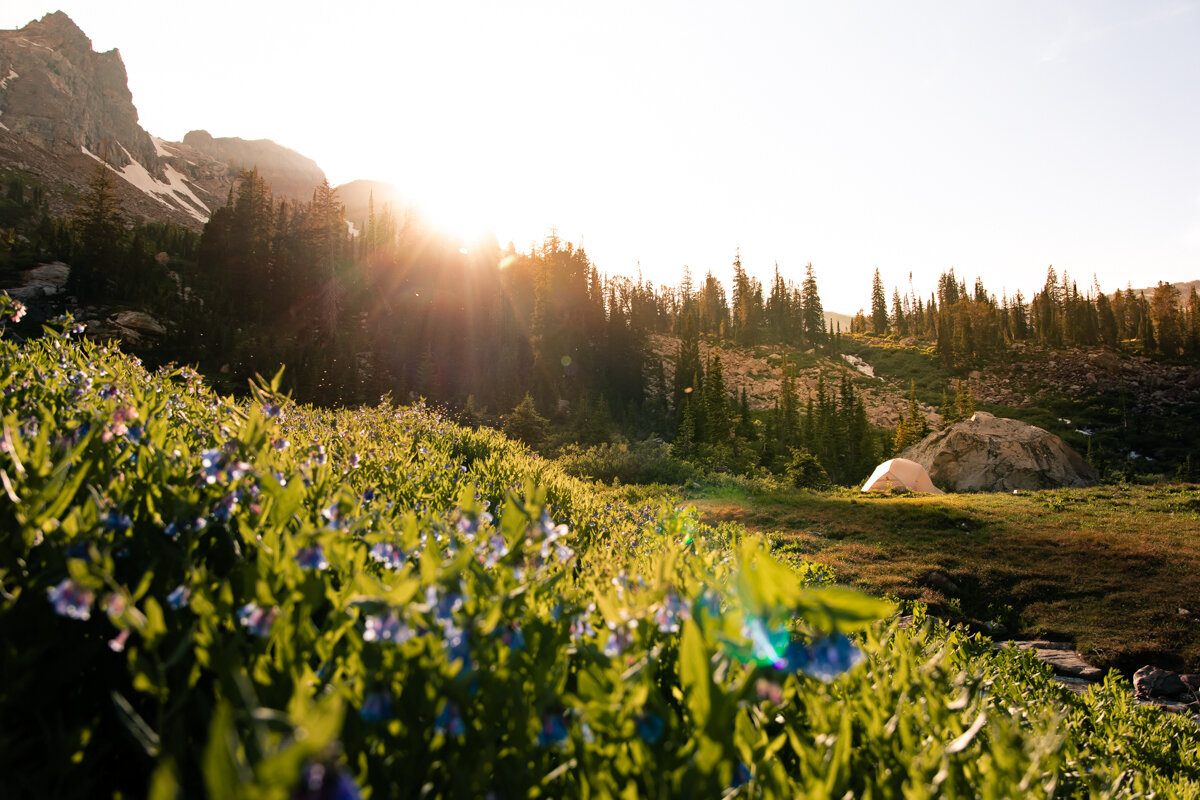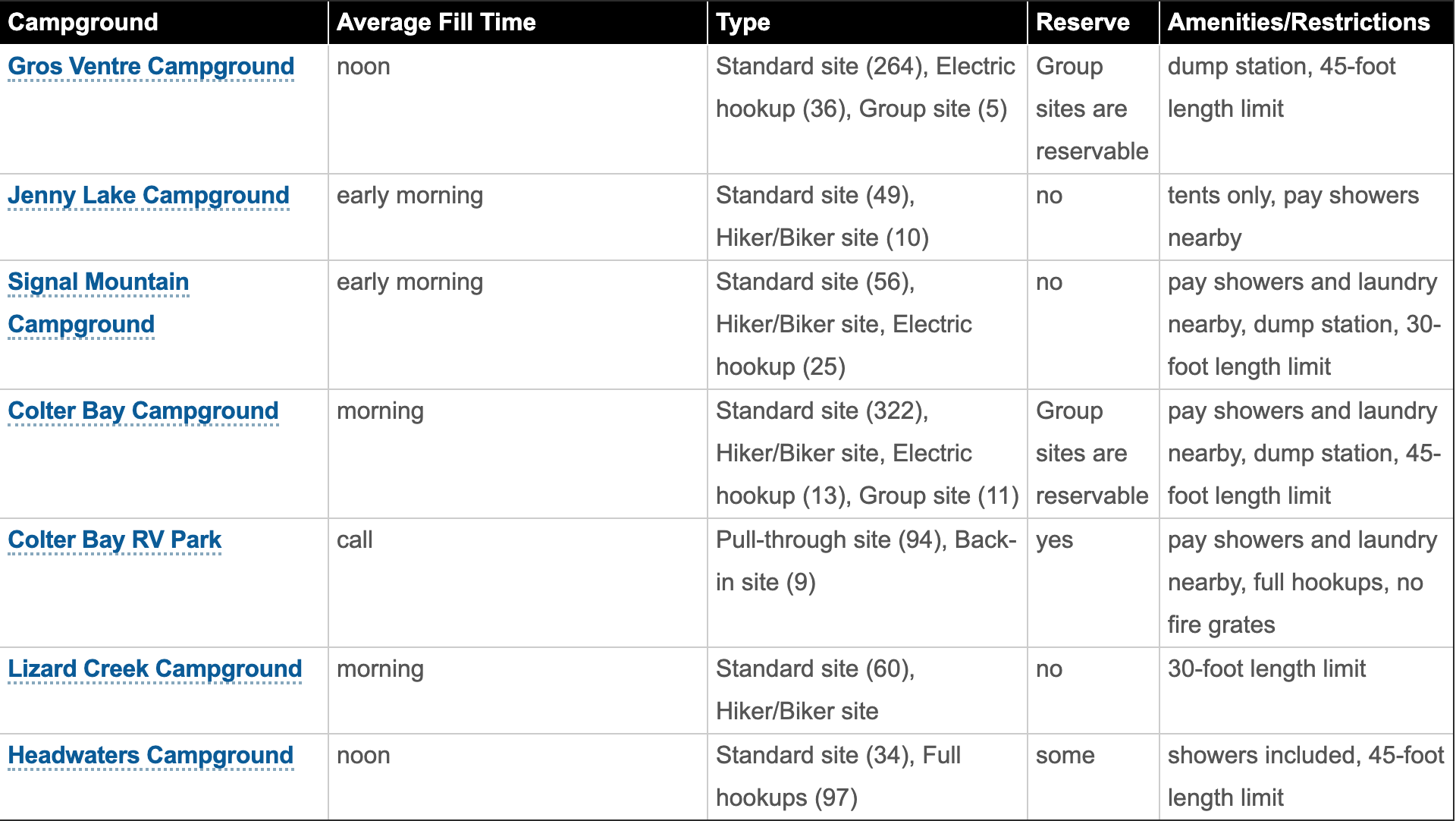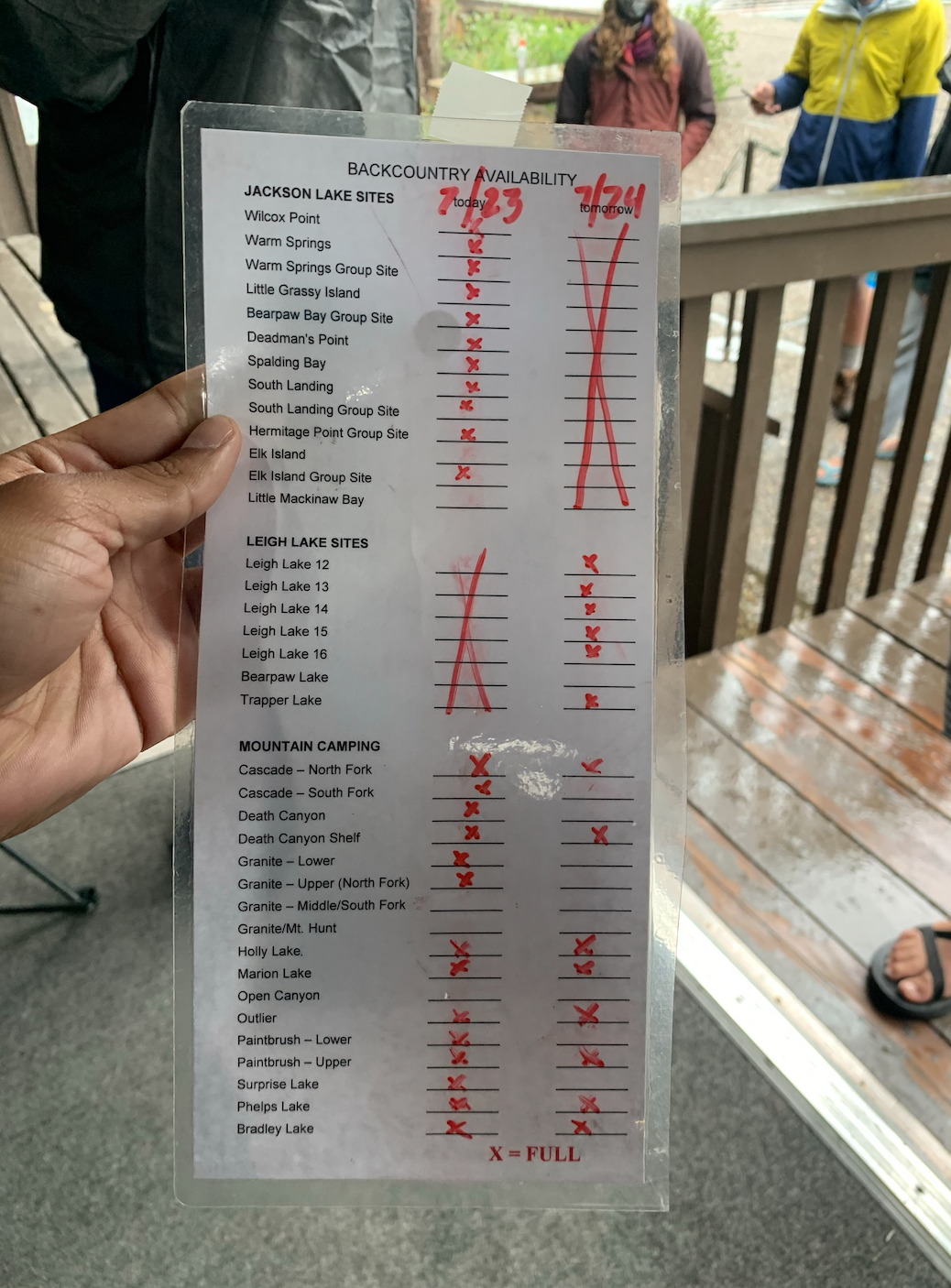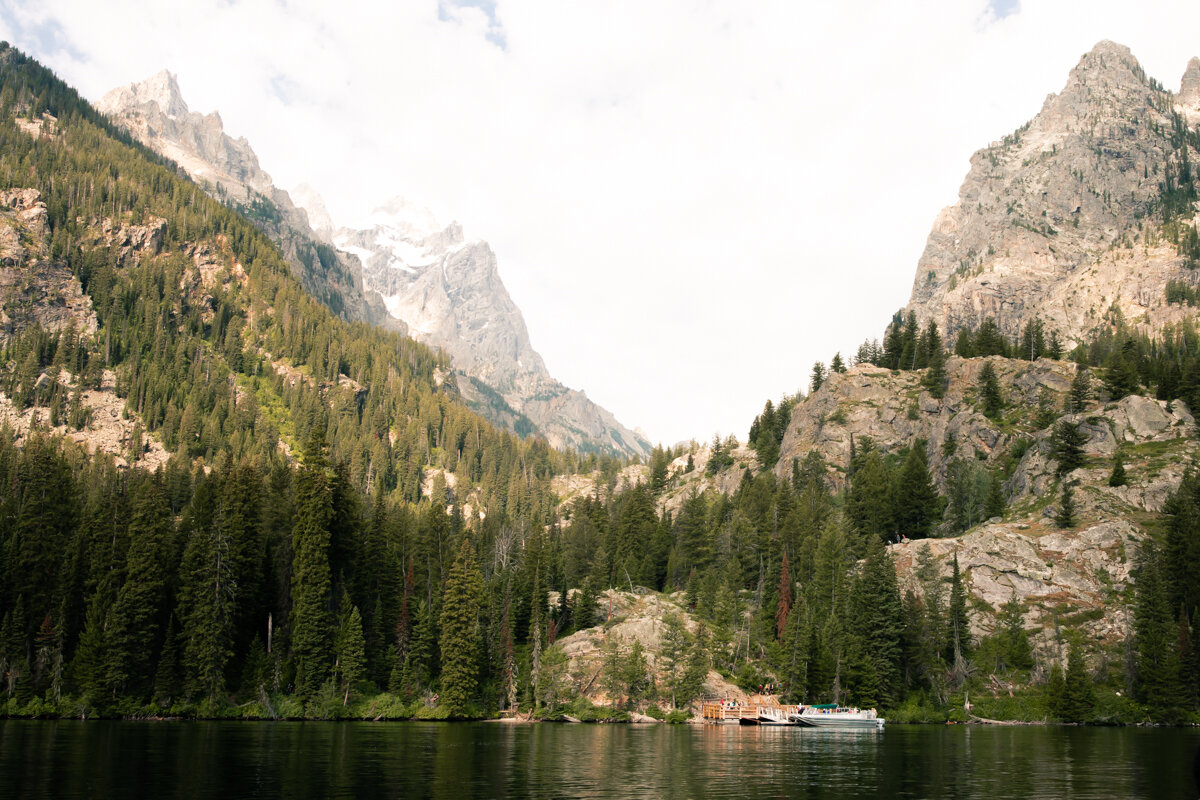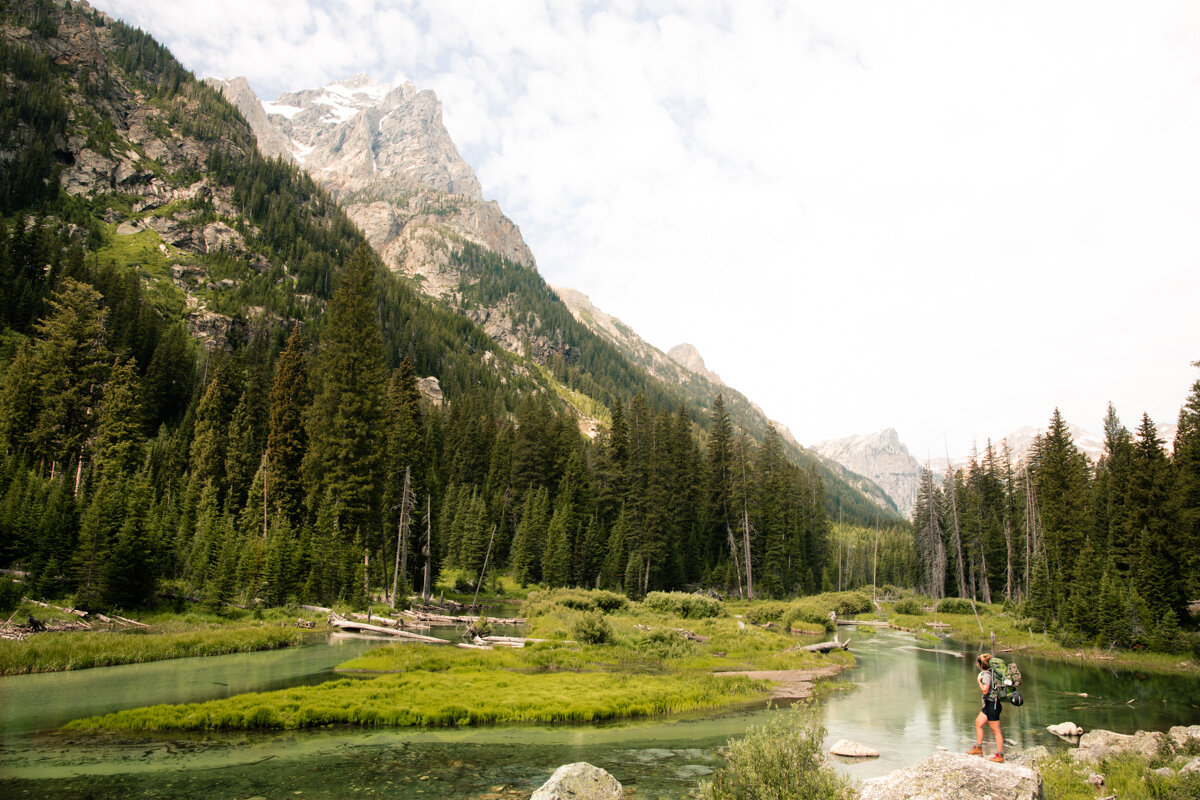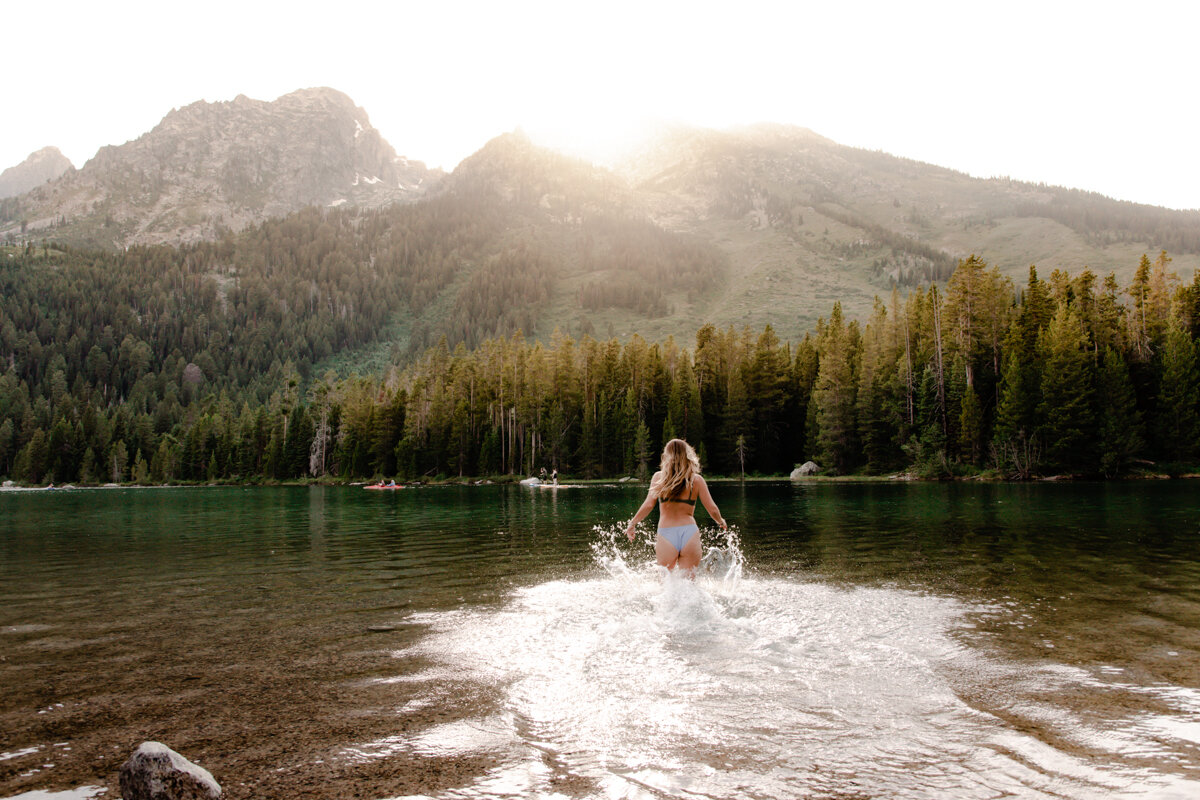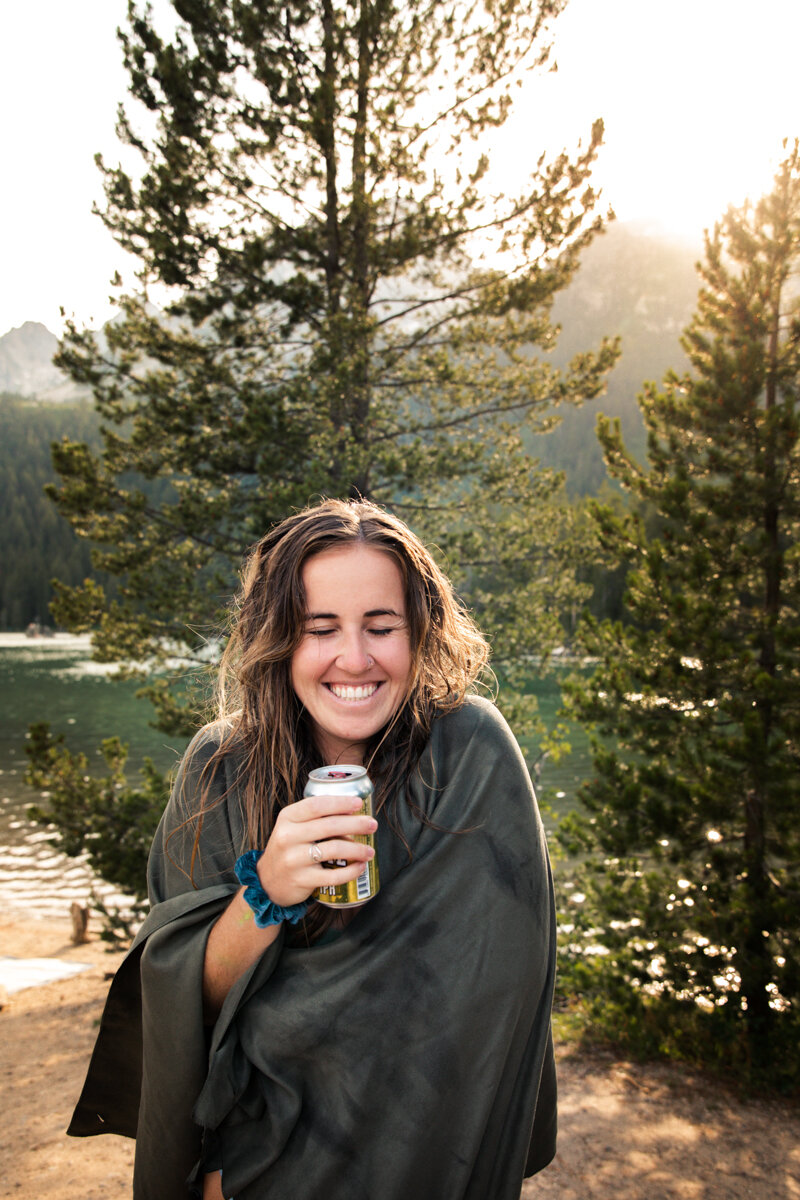Grand Teton National Park: Everything You Need to Know About Camping Under the Big Titties + 2 Trips
Imagine unzipping your tent to a moose grazing in the stream beneath the massive, orange-tinted peaks of the Southern Rockies. We're in the Tetons, people, and it's freaking GORGE.
Read on for pro tips about snagging first come, first serve campsites, exploring backcountry camping permits, and insider tips on the best dispersed camps with sick views (for free!!), plus a sweet backpacking trip (get ready to see a moose!) and a day hike to bright blue glacier water that you won't want to miss. Let's get after it!
Hey, friends! I love recommending the gear that I'm stoked about and use on the regular. As such, this post contains some affiliate links and I'll receive commission upon any purchases made through those links.
Table of Contents
At a Glance:
Location: Jackson Hole, WY
Entrance Fees: $35 for private vehicle; $70 for an annual pass; $80 for America the Beautiful Pass (highly recommend)
Native Lands: Shoshone, Bannock, Blackfoot, Crow, Flathead, Gros Ventre, Nez Perce
Size: 310,000 acres/485 square miles
Open: Year-round
Established: 1939 as a National Park
Activities: Hiking, fishing, boating, climbing, horse-back riding
Visitor Center: Colter Bay Visitor Center (open); Craig Thomas Discovery & Visitor Center (closed for COVID); Laurence S. Rockefeller Preserve Center (closed for COVID); Jenny Lake Visitor Center (currently closed); Jenny Lake Ranger Station (closed for COVID); Flagg Ranch Information Center (closed for COVID); Jackson Hole and Greater Yellowstone Visitor Center (closed for COVID)
Pro Tip: If you're venturing out during COVID, check out this resource put together by nps.gov for being #TetonSafe outside.
Things to Remember on Any Adventure
Wear a mask! Think of it as your new everyday hiking essential (just like your first aid kit, water, and comfy wool socks). It's extremely difficult to stay six feet away from others on any hiking trail, so keep a buff around your neck or your ear-strapped mask around your wrist and pull it on when passing others on the trail. It's the right thing to do!
Pack in, pack out. Let's be honest, there's nothing more gross than strolling into your backcountry campsite to find dirty wrappers and half-eaten food around your new home for the night, not to mention the negative effects this type of behavior has on the area's wildlife. Let's keep nature natural, the grizzlies eating berries, and the campsites and trails clean and healthy.
Don't forget that bear can! We're in grizzly country and bear cans are required (for good reason). Pack all your food, wrappers, smelly toiletries (like toothpaste, lotion, and deodorant) in this bad boy and keep it at least 100 yards downwind from your tent to avoid any unwelcome guests.
Stick to the trails. Venture off the beaten path but never forge your own trail. Sticking to pre-established trails keeps the surrounding environment as natural and wild as possible (and lessens risk of injury). And as GTNP's backcountry guide points out, one missed step could accidentally squash a 100-year-old plant! So sad!
Camp in designated sites We want to preserve pristine areas as much as possible, and camping in designated areas can help do just that.
Check for permits. Does your campsite require a permit? Many in GTNP do. Read up on permits and permit zones for GTNP here.
Gotta poop? Nature calls, I get it! We're all human, but poop with care, friends. Every park (and trail) has different regulations, so definitely ask a local ranger if you're not sure what to do. For example, certain trails in GTNP require backcountry composting bags (that they actually provide for free with the purchase of your permit), while others simply ask you to dig a six-inch hole before you do your business.
Packing List (5 Days in Summer)
Clothing
Moisture wicking long sleeves (2)
Moisture wicking tanks (2)
Moisture wicking tees (2)
Running/hiking shorts (3)
Workout leggings (1)
Insulating leggings (1)
Raincoat
Wool socks (one for every day)
Underwear (one for every day plus two extra)
Hiking boots – make sure you've broken them in beforehand!
Slip-on shoes for around the campsite
Swimsuit
Baseball hat
Gear/Supplies
Sleeping bag (a 20-degree bag was perfect for me)
Sleeping pad (I used this one and it worked great!)
Backpacking backpack
Bear can** (free rentals available at permit offices)
Bugspray
Headlamp
Camp stove/propane/pot/lighter (this one is so portable, we love it!)
Aeropress + coffee
Freeze-dried camp meals (3)
Microfiber towel
Water filter (We used the heck out of our Grayl)
Chapstick
Sunscreen
Any necessary toiletries (they have to fit in your bear can with your food)
Cliff bars (6)
Hard boiled eggs for breakfast
Binoculars (we didn't have these and wish we did!)
** = required
- Essential Camera Cube

- Price: $59.00
- PRVKE (ORGINAL BRANDING)

- Price: $184.00
- The Globetrotter Bundle

- Price: $454.00
From Hunting and Gathering to Oil Money Deals
11,000 years: that's how long humans have lived, hunted, and gathered upon the 33,000-acre wilderness we now call Grand Teton National Park, and I totally see why. Its gorgeous wildflower fields, massive glaciers, and wildlife made my jaw fall straight off my face and onto the floor, but besides its body-numbing beauty and bountiful seasonal riches, these mountains also hold spiritual meaning for many of the Native American tribes who shared this glorious landscape before the European explorers arrived (Shoshone, Bannock, Blackfoot, Crow, Flathead, Gros Ventre, and Nez Perce). Fur trappers came next (1800s) followed by homesteaders in the 1860s (scroll to Mormon Row to learn more), and eventually Jackson Hole tourism boomed, which tugged at John D. Rockefeller, Jr.'s deep pockets. Through a few of what locals often refer to as "sketchy deals", he bought up 35,000 acres in two decades and later donated them to the government to make "The Three Teats" a national park.
How'd it Get its Name?
My inner child can't stop giggling at this piece of voluptuous history. The Shoshone name for the park is teewinot to describe the range’s “many pinnacles," but French Canadians granted it the name we commonly use today. Basically, the group of fur traders came through and said, Aha! Les trois tetons! Which literally translates to "The three teats," and the park's largest mountain, The Grand Teton, literally means, "The big tit." I don't see it, but cheers to their creativity, I guess?
PSA: Be Bear Aware!
We're venturing into grizzly (and black) bear country, friends, which means we need to take extra care when it comes to food storage. If you're car camping, it's okay to keep your food locked away in your car (key word: locked), but it's still a good idea to make sure it's a good distance from your tent (100 yards is the recommended minimum). Many campsites (even some dispersed sites) have heavy duty bear boxes designed to safely store your food.
When backpacking, it's important to store all of your food (and fragrant toiletries) in a bear canister about 100 yards from your tent. That means food wrappers, deodorant, lotion, and anything else that's gives off a smell needs to be safely stored away to keep unwelcome visitors from knocking on your door.
What do I do if I run into a bear?
Don't run. Seriously. You thought your last boyfriend was all about the chase? Try bears. Try to stay calm and if the bear is still minding its own business, move away slowly and sideways, so you can keep an eye on the bear without tripping. If the bear follows, stop and hold your ground. Look big and use your voice. Remember, bears are the passive one in the relationship, and would rather avoid confrontation. Tell it to get lost (literally) so you can move on with your life, ahem, I mean hike.
Make sure your bear spray is easily accessible, either clipped onto your backpack or belt loop if you have one, so you can grab it in a split second if need be. One more thing: it only works if you know how to use it. Try this short 1-minute video for a quick tutorial.
All Things Camping
There are three ways to camp in and around GTNP: In campgrounds, in the backcountry, or dispersed. Here's a quick overview of all three.
1. Campgrounds
GTNP has seven campgrounds throughout the park that offer potable water, metal fire grates, picnic tables, metal bear boxes, and other amenities. Four offer reservable sites and the rest are first come, first served.
Pro tip: If you're trying to snag a first come, first served site in a campground, get there EARLY! These sites were filling up by 8 a.m. We didn't want to bother with lines (or paying the fee, to be honest), so we took the dispersed camping route.
2. Dispersed Camping: Why it's BOMB
More people are heading outdoors now than ever before, which means campsites are booking up FAST! So, if you're a last-minute camper like yours truly, then you're going to love what I'm about to tell you.
Dispersed camping is the term used for camping on public spaces that aren't already designated campgrounds. These spaces are usually in National Forests or on BLM (Bureau of Land Management) land. The clincher: there are usually no facilities (like water or restrooms). But hey, they're FREE, and a few even have bear boxes!
All regular campsite rules apply to keep these areas safe and unspoiled for future campers.
The best, best part? There's National Forest dispersed camping RIGHT NEXT TO GTNP! Seriously. A dirt road off of Highway 191 leads you to some epic sites with a gorgeous view of the Tetons. Kind of unreal.
When we weren't backpacking, we called this little lot our home.
There's also Grassy Lake Road in the John D. Rockefeller, Jr Memorial Parkway (the north end of the park by Yellowstone) with 20 dispersed campsites with vault toilets and bear boxes available. No potable water.
A short walk from our dispersed campsite.
3. GTNP Backcountry Camping (And Permits)
Oh, the backcountry: to be alone camping under towering peaks, among wildflowers and streams, and moose grazing in the distance. It's just you and the great outdoors–often with no cell service or distractions from the modern day world. It's so peaceful, well, when you arrive, but securing a permit wasn't so much "The Sound of Music" scene as the rest.
Secure in Advance if Possible
One-third of all GTNP's backcountry permits can be reserved in advance, so if you're a planner, I'd highly recommend going this route! Unfortunately, I'm very last-minute and all reservations were booked, so it was first come, first served for me! Permit fees: $45 in advance, $35 at the door
Last-Minute Travelers: Arrive Early and Stay Flexible!
We propped up our camp chairs in line at the Colter Bay Visitor Center at 7:30 a.m., 1.5 hours before opening, to hopefully secure our first-choice sites. Just before the doors opened, rangers handed us a laminated sheet of paper with X's–the empty lines were how many sites were open for the next two nights.
Pro tip: Rangers told us the Colter Bay Visitor Center was the least visited and our best bet for small lines at the permit office. Still highly recommend arriving at least an hour early!
Finally at the window, we gave our best-case-scenario plans to the ranger and she worked with us to find open sites that fit within our time period.
First come, first served sites can only be booked one day in advance.
For example, if today is Thursday, and Saturday night is the only night your preferred site is available, you'll have to book another site Friday night to secure Saturday as well.
The permit fee remains the same regardless: $35 total for up to ten nights of backcountry camping (or three nights at Jackson Lake).
Pro tip: Keep an open mind when getting your permit! The rangers are basically pro travel advisors and are more than happy to work with you to create your dream backcountry trip but due to popular demand, you might not always get your first choice. Patience and flexibility is key!
Here's a map of GTNP's backcountry hikes and campsites from their trusty guide (the two hikes we did are highlighted in orange). As you can see, there are SO many backpacking opportunities. Find the one we did below.
Backpacking Lake Solitude
16 miles round-trip (the Cascade Canyon route)
2,637' elevation
Before leaving for any adventure, I always make it a point to ask for rec's from those who've gone before me. This time, I reached out to a brand new women-focused adventure group called Outdoorsy Gals for their GTNP must lists, and Lake Solitude won by a landslide. Why? Well, to start, you can hop on a passenger ferry for a quick jaunt across Jenny Lake for $18 round trip, which is an epic way to get going if you ask me. The boat ride also ends up shaving 3.2 miles off of your 16 mile round-trip hike, which for me is an added bonus. If longevity isn't your goal, I say climb aboard and cast off for Cascade Canyon!
Pro Tip: Veer right towards the Horse Trail after docking to skip trail traffic and nasty switchbacks on the way up. Day hikers will veer left to check out Inspiration Point and Hidden Falls–save those for the way down. Shout out to our boat captain for this priceless tip!
The First Leg: Cascade Canyon
After a quick 500-foot ascent, you get to explore one of GTNP's most celebrated hikes: Cascade Canyon. Moose frequent this four-mile portion of the trail, so keep an eye out for these gorgeous beasts (while keeping your distance, of course). We saw TWO on this portion of the trail alone.
Pro Tip: Morning and evening are your best bets for moose sightings.
The hike follows Cascade Creek with little-to-no incline, which is why you'll see a lot of day hikers taking in the towering peaks, cascading waterfalls, and surrounding wildlife this gorgeous stretch has to offer.
The Second Leg: Lake Solitude Trail
Only when you veer right onto the Lake Solitude Trail at mile 5.6 (or mile 4 if you're coming from the boat dock) will you leave behind the masses. Gorgeous wildflower field after wildflower field await on this portion of the trail. You'll cross two wooden bridges (stop at the second for a quick pic!) before making the final ascent to the North Fork Camp Zone.
My goal for the trip: catch sunrise at Lake Solitude, but no lakeside camping meant I planned to snag the closest campsite possible for little-to-no early morning hiking.
You know my motto: minimal effort, maximum reward.
But in the North Fork Camp Zone, every site is gorgeous in its own way. And no, I'm not just saying that. There are sites surrounded by boulders, sites down by the stream, sites surrounded by trees, sites in a field of wildflowers, sites with epic views, and so much more. You really can't go wrong.
Somehow, despite our late start (8 a.m.), our sightseeing, our many food breaks, and our photo stops, we saw no other backpackers heading up to those sites that day, and were able to snag our first-choice site closest to the lake. Literally how?! Did the stars align? Was the universe in our favor? Are we on the adventure gods' good side?
Here's a few shots I snagged of our site at sunset!

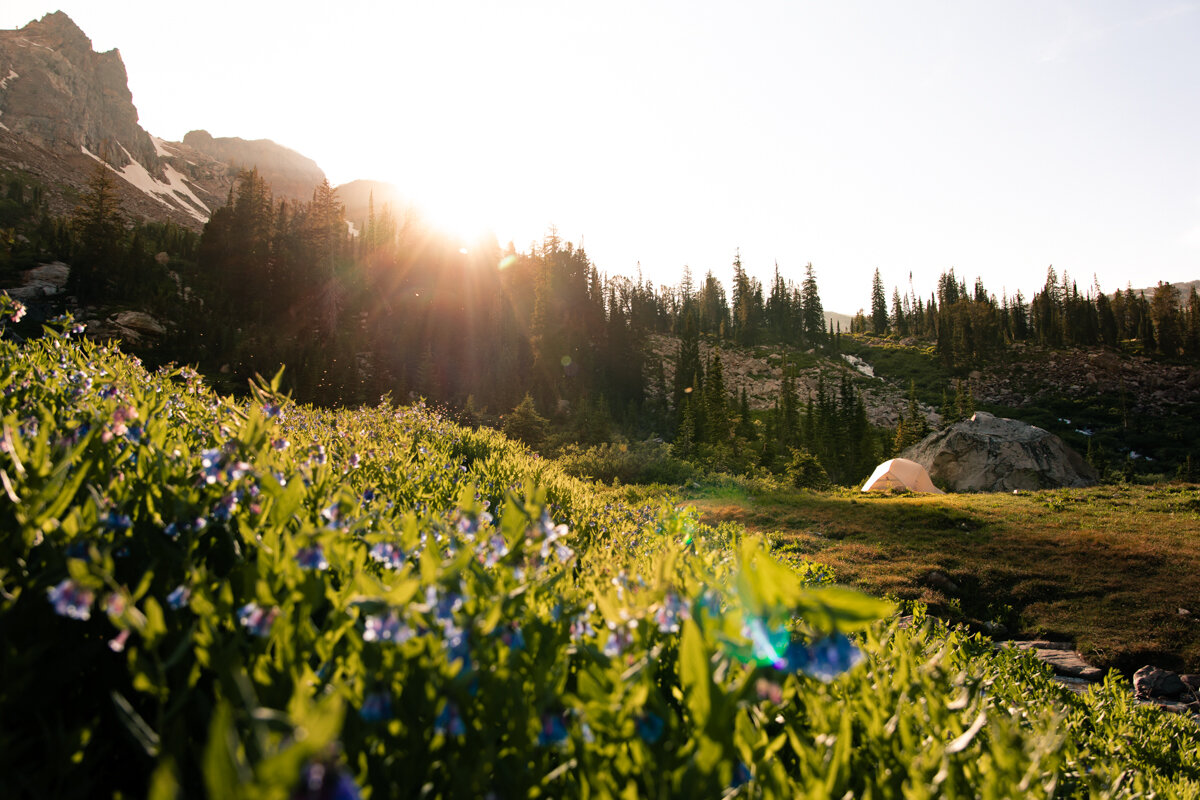
We quickly dropped our bags, set up camp, and hiked the remaining 0.5 miles to the lake's edge for a late lunch and a FREEZING swim. But so worth it. Keep an eye on your backpack, though! The marmots are bold.
Pro Tip: It's SO important to have some sort of water filter to refill your bottles on the trail, and with tons of rivers and streams around it's super easy! We used the heck out of our Grayl. All you do is fill the bottle up to the line and press the interior chamber into the holding area, which forces the water through the filter and into the drinking chamber. We used this filter to refill our Camelback too!
In the a.m., we packed up our sleeping bag, camp stove, Aeropress, and coffee, and hiked a couple hundred feet back up to the lake for sunrise. Highly recommend.
The cherry on top? Waking up to a moose grazing in the stream not far from our tent. There are very few times I choose to leave my camera behind. This was one of them. Nature is pretty freaking amazing.
Optional: The Cascade Canyon/Paintbrush Canyon Loop
We were tempted to say f*** it and go all in with a two-night, 22-mile loop (including Jenny Lake) up Paintbrush Canyon, through the pass, down past Lake Solitude, and through Cascade Canyon to the boat dock, but cramp ons and an ice axe were required and we were SO unprepared. We did the safe thing (and we also really wanted to make it over to Delta Lake before we had to drive home) and saved that portion for another time.
I've heard nothing but great things! If you do decide to give the loop a go, pleaseee let me know how it is!
Just driving through? Check out 3 Must-Visit Roadside Photo Spots in Grand Teton National Park.
Delta Lake: Day Hike
9 miles round trip
2,329' gain
Out and back
This is another local rec and well worth the scrambles at the end! You won't find this lake advertised on any national park website. Why? Because it's not maintained, so it's good to assume a small level of risk while hiking this portion of the trail. The hike starts from the Lupine Meadows trailhead and heads up the Amphitheater Trail. At mile 3.5, you'll veer right at the fifth switchback and onto an unmarked trail, immediately heading down a few wooden steps. Again, this trail isn't maintained, and it's important to track your distance to know when to make the turn–it's easy to miss!
Expect ups and downs with plenty of rocks and a few fallen trees. Don't forget to occasionally take your eyes off your feet and check out the view! It's epic!
Wildflowers will accompany you all the way up to the lake. Two boulder fields (follow the cairns to stay on the trail) and two steep scrambles later (we took lots of breaks), you'll emerge from the trees to the gorgeous, milky blue waters of Delta Lake. It was INSANE!
We veered right, crossed the river, and found a nice lakeside boulder to spread out on, enjoy a snack, and doze off for a two-hour nap. Don't be fooled by the floaty photo–that water was SO NOT warm.
Pro Tip: Turn this day hike into a backpacking trip by camping at Surprise Lake, just 1.5 miles from the offshoot to Delta! Permits required. See above backcountry map for reference.
Pro Tip: End your backpacking trips with a jump in String Lake! It's MUCH warmer than either Delta Lake or Lake Solitude, promise! These daily dips were our "showers" while in GTNP!


